
http://www.iaeme.com/IJM/index.asp 153 editor@iaeme.com
International Journal of Management (IJM)
Volume 7, Issue 7, November–December 2016, pp.153–161, Article ID: IJM_07_07_016
Available online at
http://www.iaeme.com/ijm/issues.asp?JType=IJM&VType=7&IType=7
Journal Impact Factor (2016): 8.1920 (Calculated by GISI) www.jifactor.com
ISSN Print: 0976-6502 and ISSN Online: 0976-6510
© IAEME Publication
ROLE OF HRM PRACTICES IN KNOWLEDGE
MANAGEMENT OF IT/ITES ORGANISATIONS
Mr. R. Anbu Ranjith Kumar
Research Scholar, Department of Management Studies,
Karpagam University, Coimbatore, India
Dr. S. Balasubramanian
Chief Editor, IAEME Publication, Chennai, India
ABSTRACT
Human Resource Management (HRM) involves all the management decision and practices that
directly affects the people, or human resources, who work for the organization. The present study
explores and compare the various HRM practices in, two different organizations—IT/ITES based
organization. The present study aim at assessing the commitment of the two industries attribute to
the HRM practices. The present study aim at role of the HRM practices in knowledge management
of this organization.
Key words: HRM, IT/ITES
Cite this Article: R. Anbu Ranjith Kumar and Dr. S. Balasubramanian, Role of HRM Practices In
Knowledge Management of IT/ITES Organisations. International Journal of Management, 7(7),
2016, pp. 153–161.
http://www.iaeme.com/IJM/issues.asp?JType=IJM&VType=7&IType=7
INTRODUCTION
The key issues of any HR department in IT organizations are employee acquisition, retention, training and
development, performance management, talent management and keeping talent is a big challenge for today’s
organizations because of more opportunities available outside. This is especially true for the Indian IT
organization.
Salaries of the Indian IT workforce increased 10 to 15% or more annually from 2002 to 2014. But the
attrition level also increased with an approximate increase of 15% to 30% every year From 2002 to 2014
Employee turnover is one of the major challenges of an IT organization. Therefore, retention of talented
and skilled manpower becomes crucial because it creates a competitive advantage for the organization.
RESEARCH METHODOLOGY AND SAMPLING
The question survey technique is used to solicit the data. The questionnaires are answered by managerial
personnel of IT and IT Enabled companies located in India. A total of 250 sets of usable questionnaires
were successfully collected and analysed.

R. Anbu Ranjith Kumar and Dr. S. Balasubramanian
http://www.iaeme.com/IJM/index.asp 154 editor@iaeme.com
Six different sections of questions are developed in the questionnaire, which are (1) Recruitment
(selection), (2) Training, (3) Employee Involvement, (4) Performance Assessment, (5) Compensation, and
(6) Retrenchment. Several behavioural factors and non-behavioural factors are stipulated and respondents
are asked to indicate the importance of these factors in selecting the employees.
The data is collected from all the organization by person. The respondents are any operational or
managerial people working in the software organization. The respondents are asked to fill the questionnaires.
1. SELECTION PROCESS
1. Preliminary Interview: The purpose of preliminary interviews is basically to eliminate the unqualified
applications based on information supplied in the application forms. The basic objective is to reject misfits.
2. Selection Tests: There are various types of tests conducted depending upon the jobs and the company. These
tests are Aptitude Tests, Personality Tests, and Ability Tests which are conducted to judge how well an
individual performs the tasks related to the job. Besides this there are some other tests like Interest Tests
(activity preferences), Graphology Test (Handwriting), Medical Tests, Psychometric Tests etc.
3. Employment Interview: The next step in the selection is employment interview. Here interview is a formal
and in-depth conversation in the applicant’s acceptability. It is considered to be an excellent selection device.
Interviews can be One-to-One, Panel Interview, or Sequential Interviews. Besides there are Structured and
Unstructured interviews, Behavioural Interviews, Stress Interviews.
4. Reference & Background Checks: Reference checks and background checks are conducted to verify the
information provided by the candidates. Reference checks are through done the formal letters, and telephone
conversations. However it is merely a formality and selections decisions are seldom affected by it.
5. Selection Decision: After obtaining all the information’s, the most critical step in the selection is decision
making. The final decision has to be made out of applicants who have passed in the preliminary interviews,
tests, final interviews and reference checks. The views of line managers are considered generally because it is
the line manager who is responsible for the performance of the new employee.
6. Physical Examination: After the selection decision is made, the candidate is required to undergo a physical
fitness test. A job offer is often contingent upon the candidate passing the physical examination.
7. Job Offer: The next step in the selection process is job offer to the applicants who have crossed all the previous
hurdles. It is made by way of letter of appointment.
2. TRAINING AND DEVELOPMENT
There is no pre-determined "check list" regarding the type of training needed for the employees who meet
the performance expectations. Since each individual is different, supervisors have to make a thorough
assessment of the type of training needed. Human Resource Management Services conduct a yearly training
needs assessment to ensure the programs which are being offered to meet the agency’s requirements.
Agencies can also contact Human Resource Management Services to arrange for a specific training based
performance on management review, revised missions and vision, etc.
There are core or basic training programs needed when a person accepts supervisory or management
positions, such as:
• Understanding management, organizational and motivational theory, and application
• Planning, setting, and carrying out organizational objectives
• Planning and leading effectively
• Specific training needed when an individual enters a supervisory position is:
• Planning, scheduling, and delegating work assignments.
• Communicating, handling conflict, and handling grievance procedures.
• Understanding various state and federal employment laws.
• Interviewing and completing performance management reviews.

Role of HRM Practices In Knowledge Management of IT/ITES Organisations
http://www.iaeme.com/IJM/index.asp 155 editor@iaeme.com
• Setting unit goals and objectives.
3. STUDY OF EMPLOYEE’S INVOLVEMENT IN AN ORGANISATION
A place where individuals from different backgrounds, religions, communities come together on a common
platform to work towards a predefined goal is called an organization. Every organization has a set of
principles and policies mandatory for all the employees to follow.
The beliefs, ideologies and practices of an organization form its culture which gives a sense of direction
to the employees. The work culture goes a long way in creating the brand image of the organization and
making it distinct from its competitors. The employees are the true assets of an organization. They are the
ones who contribute effectively towards the successful functioning of an organization. They strive hard to
deliver their level best and achieve the assigned targets within the stipulated time frame.
The employees play an important role in deciding the culture of the workplace. Their behaviour, attitude
and interest at the workplace form the culture.
The factors which affect the employees work culture is given below:
Organization A
The employees are least bothered about the policies of the organization and attend work just to sustain their
job. For them the workplace is nothing but a mere source of earning money. In such a scenario, people
seldom get attached to their organization and thus move on in a very short span of time.
Organization B
In the organization B, employees are particular about the rules and regulations of the organization and adhere
to the set guidelines. The individuals focus on their work and look forward to achievie it well ahead of the
deadlines. People stay away from the unnecessary gossips and prefer sitting at their workstations rather than
loitering around.
Organization C
Organization C is a male oriented organization where male employees dominate their female counterparts.
Frequent late sitting is a regular feature of the organization culture. Employees prefer staying back late to
finish off their pending work. No organization expects its employees to stay back; it is the employee for his
own convenience adjusts the timings and makes it as the culture of the workplace
4. PERFORMANCE ASSESSMENT OF THE EMPLOYEE
Performance Management began around 60 years ago as a source of income justification and was used to
determine an employee’s wage based on performance. Organisations used to drive behaviours from the
employees to get specific outcomes. In practice this worked well for certain employees who were solely
driven by financial rewards. However, where the employees were driven by learning and development of
their skills, it failed miserably. The gap between the justification of pay and the development of skills and
knowledge became a huge problem in the use of it. This became evident in the late 1980s; the realisation
that a more comprehensive approaches to manage and reward the performance was needed. This approach
of managing the performance was developed in the United Kingdom and the United States much earlier than
it was developed in Australia.
In recent decades, however, the process of managing people has become more formalised and
specialised. Many of the old performance apparel methods have been absorbed into the concept of
Performance Management, which aims to be a more extensive and comprehensive process of management.
Some of the developments that have shaped Performance Management in recent years are the differentiation
of employees or talent management, management by objectives and constant monitoring and review. Its
development was accelerated by the following factors:

R. Anbu Ranjith Kumar and Dr. S. Balasubramanian
http://www.iaeme.com/IJM/index.asp 156 editor@iaeme.com
• The introduction of human resource management as a strategic driver and integrated approach to the
management and development of employees; and
• The understanding that the process of Performance Management is something that's completed by line
managers throughout the year - it is not a once off annual event coordinated by the personnel department.
5. COMPENSATION
To maintain high standard of productivity and service, the organization must motivate employees. A suitable
compensation, incentives and rewards program is the key motivator in any organization today. In order to
motivate employees and boost their morale to achieve desired performance levels and goals, compensation
plays a key role. In order to achieve more incentives and compensation, employees raise their performance
levels
6. DATA ANALYSIS AND INTERPRETATION
Selection of Employees
TABLE 1 Selection of Employees
Behavioural factors Mean S.D
Ability to communicate effectively 4.51 0.72
Able to work in team or group efficiently 4.40 0.73
Interest or affinity for that job 4.15 0.78
Willingness to exchange ideas 3.90 0.79
Creative and innovative 3.91 0.79
Values that fit in with organization 3.90 0.85
Dare to challenge exiting assumptions 3.75 0.96
Multilingual ability 3.40 1.00
Non-behavioural factors
Knowledge currently seeks by organization 4.10 0.81
General computer literacy 4.00 0.84
Marketing capabilities 3.90 0.91
Related professional experience 3.85 0.92
Strong commercial awareness 3.83 0.90
High level of ICT knowledge 3.70 0.91
Knowledgeable on others disciplines 3.65 0.85
Good command of written and spoken English 3.40 1.01
Active in external professional network or association 3.25 1.05
Source: Data analysis report from Primary Data Collected through Questionnaire Method
Training and Approaches
This section covers the areas where training is conducted, and the approaches taken during the training. The
Table 2 documents the training areas investigated and statements pertaining to train the approaches.

Role of HRM Practices In Knowledge Management of IT/ITES Organisations
http://www.iaeme.com/IJM/index.asp 157 editor@iaeme.com
Table 2 Training Areas and Approaches
Types of Training Conducted Mean S.D.
Documentation of procedures and processes 3.55 1.20
Problem solving skills and techniques 3.53 1.21
Industry and business knowledge 3.50 1.15
Quality initiatives 3.40 1.21
Interpersonal communication 3.35 1.22
Customer relationship management 3.25 1.30
Team concepts/working in groups 3.25 1.30
Managing performance 3.22 1.30
Leadership 3.15 1.25
Company mission and values 3.12 1.29
Skills to build teams 3.13 1.30
Information Communication Technology (ICT) 3.00 1.31
Skills to build empowerment 2.92 1.32
Managing change 2.92 1.30
Creativity/innovation 2.80 1.31
Coaching skills 2.81 1.50
Stress management 2.42 1.60
Approaches in Training
Making sure that trainees understand the general principles and rationale
behind the skills they are learning
3.58
1.20
Ensure that what is being learned in training will be supported by colleagues,
peers, and top management
3.33 1.23
Many examples are being used during training by presenting various contexts
in which trainees can expect to use the skills and knowledge learned in
training
3.30 1.24
Varying the training setting to show trainees that classroom is not the only
place where knowledge and skills can be learned
3.27 1.27
Open and supportive organization policies in rewarding and recognizing
trained staff
3.25 1.27
Intensive drills and practice techniques for trainees to reach a level of
automatic implementation on the job
3.20 1.20
Visual displays of information are offered to boost training transfer 3.19 1.31
Letting trainees explore the training content before training actually begins 2.85 1.40
Source: Data analysis report from Primary Data Collected through Questionnaire Method
Performance Appraisal
This section investigates the degree of matches between the characteristics of performance and appraisal
system with the surveyed companies as shown in the Table 3

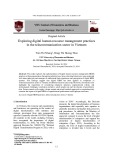
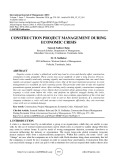
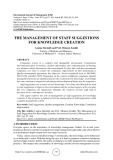
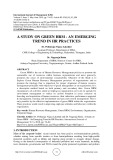
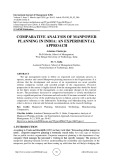
![Đề án quản lý và phát triển nhân sự tại đơn vị cấp phòng [Chuẩn SEO]](https://cdn.tailieu.vn/images/document/thumbnail/2017/20170419/msy1976/135x160/2751492583749.jpg)
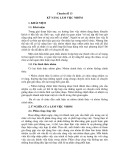

![Tài liệu đào tạo, bồi dưỡng lãnh đạo cấp phòng [Mới Nhất]](https://cdn.tailieu.vn/images/document/thumbnail/2017/20170210/nomoney3/135x160/2145657834.jpg)

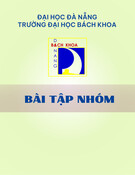






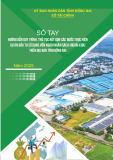
![20 câu hỏi Quản lý dự án phần mềm có đáp án [mới nhất]](https://cdn.tailieu.vn/images/document/thumbnail/2025/20251003/hieu2004haha@gmail.com/135x160/78791759734259.jpg)


![Tài liệu Quản lý dự án: Kiến thức nền tảng toàn diện [chuẩn SEO]](https://cdn.tailieu.vn/images/document/thumbnail/2025/20250910/kimphuong1001/135x160/92631757496585.jpg)



